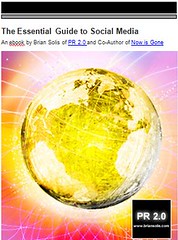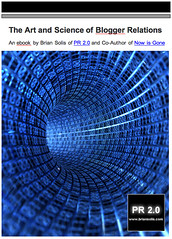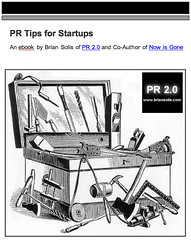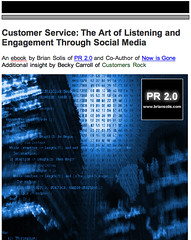Enough Already: Getting the Social Media Release All Wrong

After spending a week writing “Social Media Killed the Press Release Star,” which painstakingly explains in great detail the need to improve the content and overall relevance of PR and press releases as well as putting a microscope on why the hell a social media (or let’s just call it “an overhauled”) release WILL exist, people still don’t get it.
Good friend, Stowe Boyd wrote an interesting post that I’m afraid is drawing the wrong kind of attention to an important movement...the need to improve PR and fix everything that's wrong with the press release.
Ally, Robert Scoble unfortunately jumped on the bandwagon as well tearing down the SMPR without proper background on the subject and what we’re trying to do with it. But, he did accurately capture the essence of why I’m working hard to change the game with his comment, “I really don’t get why society needs a stupid press release.”
Fellow comrade, Jeremy Toeman at LiveDigitally asked if it’s time to kill the press release. His thoughtful observation was a little more on target, claiming “Reporters for more traditional outlets don’t necessarily deserve to have their worlds come crashing down just because us “hooligan bloggers” don’t have the patience to read through a full-page of carefully crafted spin information.”
Stowe asked, “Why not just use blogs? Why do we need these so-called "social" press releases?”
Scoble demanded, “Just give us a damn demo of your product and tell us about it.”
Indeed blogs and videos are a part of communicating with people to spark many-to-many conversations and it takes an entirely new level of PR to legitimately engage without being portrayed as fake or plastic. It takes experience, honesty, and an understanding of what they’re talking about and why it benefits readers – most PR professionals are not even close to approaching the market at this level, though they should be.
In addition to providing newsmakers with a better source for writing their stories, blogs are a natural way to also start conversations (eliminating the robotic process of companies talking “at” markets).
Video demos are also exactly where PR needs to go. It’s now easier than ever to capture and share video with bloggers, reporters, and people. Consider it the “new” video news release if you will.
But blogs and video demos aren’t ready to displace press releases – at least not yet – and at the end of the day, they are additional ways to open dialogue. It’s all about the steps that get us out of using painfully out-of-date tools that have no place in the world of socialized news and the sharing of information.
Hence, the need for a tool that provides information in a way that works across a spectrum of applications, while getting us one step closer to creating a closer relationship between producers and consumers, companies and customers, and most importantly between THE people that comprise all of the above segments.
The truth is that the wires are getting it all wrong as the IR Web Report points out. And, it’s polluting the intention behind this movement and stripping away credibility away from those of us who are diligently working on fixing something that has been broken for a long, long time.
Someone on the panel misused the term “audience” which in all honesty has no place in the world of social media. According to Stowe, “Please, please, please don't talk about audiences when you are theoretically promoting social media. As Jay Rosen has suggested, we are the people formerly known as the audience.”
He’s absolutely right. In the discussion of press releases with PR people who are starting to learn about social media, “audiences” still speak volumes when discussing the distribution and dissemination of news to various readers – unfortunately, many people aren’t there yet and they’re not connecting audiences with people. But “People” is also too generic when looking through the scope of a sniper rifle. It begets further division in order for PR to connect at a deeper and more meaningful level…
So, let’s get this straight.
Audiences = people
People = various groups of individuals with common wants and needs
PR can only participate in the conversations when it can truly understand those unique and important wants and needs.
Stowe did accurately point out that most PR is complacent and old school, “The ‘wink, wink, nudge, nudge’ complicity of leading PR bloggers around serious flaws in the conventional notions of PR is lamentable. For example, seeing the bloggers acknowledge on one hand that CEOs don't actually provide those quotes that are stuck into press releases while on the other hand promoting transparency and openness in corporate communications was more than painful.”
But, let’s be clear! There isn't any lamenting or mercy coming from this PR blogger. I've been pretty frank with the need to improve things at every level in PR, not just writing, and have gone to great lengths to help those who feel there's an opportunity to improve.
Brian Oberkirch replied to Stowe’s post with, “I do think something like hRelease would be good, as it would permit people to clearly round up the 'official' company responses to things and make them a part of larger discussions. The ails that plague press releases have nothing to do with slapping a Technorati link on them.”
Look, it all starts with the need to tell a better story in a way that means something to someone. One release no longer serves everyone. With wire services and savvy web marketers placing them in search engines as well as news desks, it's now more important than ever, to improve the foundation. Garbage generates garbage. Benefits and relevance specific to individual needs produces interest and ignites dialogue.
Journalists and bloggers aren’t the only reader of releases these days; they're now actively consumed by customers as well. 51% of IT professionals reported that they learned about new technology by reading releases on Yahoo over tech publications. That’s a HUGE shift and should spark an urgent need to transform the release into something more substantive for the needs of specific customers.
Remember, it's the substance, significance, and honesty that press releases lack. The rest is technology.
The idea behind the SMR aka hrelease aka Social Media Release aka New Media Release is a bit off in Stowe’s post and among other critical PR bloggers and practitioners. It’s not about capitalizing on trends in order to take an archaic, dying press release formula and present it to newsmakers in a fancy new package labeled as “social media” just because it has trackbacks, Technorati tags, RSS feeds, links, etc.
The IDEA is to strip out all of the bullshit and hype from traditional mechanical, and useless press releases and rebuild it as a focused compilation of relevant facts, links, media and a subscription feed to help readers write, tell, and share a story their way (without having to sort through a sea of crap to find out what's real, what's canned, and what's important.) This is what a good release should be anyway, regardless of trends and titles. Basically it’s the press release redux. It takes out what’s wrong with press releases and modernizes them into a usable format for journalists, bloggers, and individuals.
If you don’t get it, then move on, really. Keep using press releases with fake quotes, jargon, hyperbole, and paragraphs full of ridiculous details that have no relevance to anyone. Pay $1,000 for a wire service that will only end up in search engines, not in the news. Forget that the web in-of-itself represents a new kind of “wire.” Ignore the shift that has already taken place. Bitch about it, correct us, harp on the irrelevant details, cast all the stones you want, but don’t do so without getting your facts straight.
At the end of the day, what matters is that some of us will continue take the arrows in the back in order to change what’s wrong with PR while demonstrating success. All this, so that others can get better at what they do, and in the process learn how to engage individuals in a way that transcends the one-AT-many (audiences) approach to many-to-many conversations (with people).
Update: Chris Heuer adds perspective and insight to the conversation.
Update: The other side of the story starts to come into play over at Touchstone. Are You Paying Attention?: Sunday morning snippets
Digg this!
Vote at NewPR
Stowe+boyd Jeremy+toeman livedigitally release smpr hrelease brian+solis social media social+media Robert+scoble jeremiah+owyang pressrelease press+release public+relations pr2.0 newmedia tom+foremski socialmediaclub chris+heuer












6 Comments:
Really great and insightful explanation of what we are facing and what we are trying to accomplish. Much more eloquent and pointed than my 'defensive' post. Thank you for telling our story so well - you truly do 'get it' better than almost everyone else I know in the business...
Brian,
First. This is quite the manifesto. Thank you for putting so much time into such a specific response to everything that's going on (this week especially).
One thing that I think most people are forgetting about is all the other press releases. The ones besides the consumer product launches. There are thousands of releases issued every day. Of those, few are announcing new product launches or something that would necessitate a social media release, mnr, nmpr, storycrafter,
PRX, hRelease, etc.
Is this the problem? Yes and no.
Yes: Wouldn't it be great if corporations saved some of their communication budgets to make larger and more impactful announcements? Yes and no. (Yes, they'd be more significant. No, it would be terrible for SEO.)
No: The majority of press releases that are targeting small trade publications, local print, local broadcast, etc. are numerous.
Should ACME send their press release about a new Managing Director of Doohickies out in a format that costs a lot more time and money? No and no. Sure, it could be blogged about, but there would be hundreds of journalists missing the release and it doesn't meet disclosure (assuming ACME is publicly traded).
What about an earnings reports for Big Oil, Inc. (yes and no. Imagine CEOs delivering the state of their union via an MNR)? How about an update announcement for powerline outages for Smog and Coal Energy Co. after a hurricane?
My point is: All the linked-to arguments resonate with tech crowds and consumer groups because MNRs are the most effective way to get news out to every audience/person... especially those who know what a trackback and blog is. BUT, when it comes down to it, sending a release out (especially an optimized NMPR) is the easiest, and most efficient and effective way to get the most possible clicks/readers/conversations/sales and largest impact. Doing both is the best of both worlds, which is what we do.
As someone who presents and counsels many of the largest agencies in NY, I'm fighting an uphill battle. This makes your blog
an invaluable resource and ally.
So, as always, thanks again for your 25 cents.
David Weiner, PR Newswire
I agree. I don't see the press release disappearing but it seems to me that the press release in whatever form it takes, will be increasingly redundant unless it is part of an overall communications presence.
People don't like/have become cynical about releases because they are pronouncements from on high which, to varying degrees, are trying to "sell" us something. In an age of online dialogue, that becomes increasingly at odds with the general mood. But if a company/organisation constantly reveal its beliefs and behaviours via devices such as blogs, then I think it is foolish for people to believe that a certain type of press release should not be effective and accepted alongside these tools.
Recipients increasingly avow their right to decide on what is "true" but that does not deny the issuer the right to make their "pitch". Indeed, knowing that the pitch will be dissected may lead to their crafting better releases in the first place.
When doing the video demos, please make sure it is accessible to deaf people such as captioning.
Good to see people getting emotional about this subject. God knows, the old press release needs to be harassed into history.
I suspect that some of the emotion is being generated (maybe even without those involved realising it) because the hRelease/SMNR is an idea that is trying to create another construct to superimpose over the dry, deathly old one.
In the spirit of the web these days being more about de-constructing old mores than about constructing new ones that are just as problematical, I thought I'd ask...
Do we really need another construct (the SMNR/hRelease) that defines the tool enabling transfer of information between the originator of the conversation and the initial receiver of the information. Don't we have email already?
Surely we are talking about conversations here. I don't remember ever needing a format to enable me to start a conversation?
The web is enabling us to have conversations just as we always have, only with people we have never met before (everyone), and with richly interacting tools that enable us to aggregate views and actions for the improvement of our knowledge and experiences.
Do we need a tool to start those conversations and enable them or do we just need a web page from which we can drag and drop possible additional tools (Digg, De.licio.us, etc) into an email that we then send to one blogger, then a new and potentially very different email and attached tools to another, etc., etc.
Surely we are moving towards the age of individual communications that respect and acknowledge individual differences rather than towards a new 2.0ed mass communications format?
Not saying, just asking.
Lyle
Brian - The other thing we're overlooking here is that while Scoble and Stowe may have opinions on this and are influential in certain industry circles, they are NOT journalists. I would not create a social media news release or a plain old news release to reach out to them.
So not only am I unsure why there is a fight about this, I'm not sure why they have a dog in the fight.
Post a Comment
<< Home